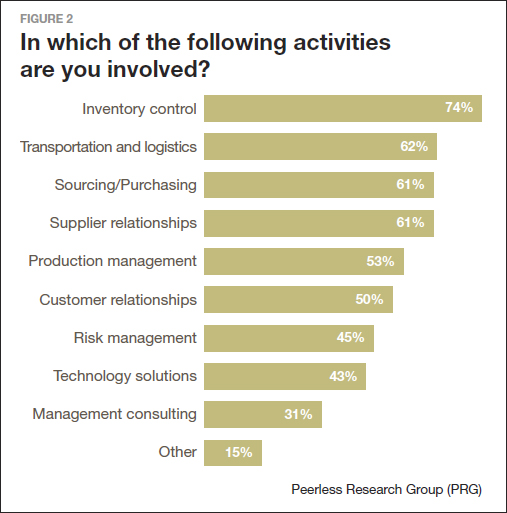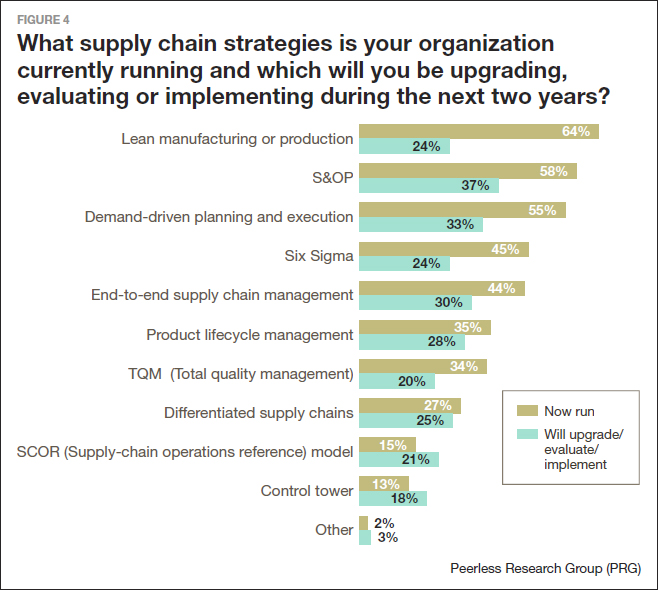A Portrait of the Supply Chain Manager

Who is today’s supply chain manager, and, how did he - or she - get to where they are in their career? These are some of the questions answered by readers of Supply Chain Management Review and members of the APICS Supply Chain Council.
It’s been written that a career in supply chain management can be like climbing a mountain.
While there is often a map for the path forward in professions like accounting, medicine and the law, in supply chain management - as with mountaineering - there are any number of paths that can reach the summit.
Those were among the findings from a research series conducted for the Council of Supply Chain Management Professionals (CSCMP) and published in the July/August 2015 issue of Supply Chain Management Review, and reinforced by research conducted by McKinsey & Company and Kuhne Logistics University.
Read the Article: Time to Get Supply Chain Management to the Board
The latter, for instance, found that while many supply chain management executives had experience in logistics, procurement and sales/marketing, “... a surprising number of supply chain executives are appointed without any previous exposure to SCM…in our sample, supply chain executives spent 88% of their previous career span outside the SCM function.”
Are those findings consistent with readers of Supply Chain Management Review and members of APICS Supply Chain Council? And, if so, who is today’s supply chain manager? And, how did he - or she - navigate to their position on the mountain?
Did they start out in the supply chain going back to their college days, or, as in the McKinsey study, did they come into the profession from other parts of the organization?
Moreover, what are their duties today and how do they see the job changing?
Those are questions we set out to answer in a collaborative survey across Supply Chain Management Review readers and the members of APICS Supply Chain Council (see About our research). Perhaps, as you read through, you’ll recognize your own career in the portrait of “today’s supply chain manager.”
A Look at the Landscape
Before diving into the results, it’s important to set the scene by examining the current supply chain landscape. There is no question the supply chain field is experiencing rapid change and growth. Technology and globalization have changed the skillset required to be successful as a supply chain professional.
Those pursuing supply chain careers need to understand not only their organization’s supply chain, but also those of their customers, vendors and suppliers. Few business functions today require this vast range of expertise, and employers are making significant investments in training to keep up.
Despite the best efforts of educators and employers, fast growth has resulted in a substantial talent gap. Eighty-four percent of executives in a recent survey agree there is a talent shortage in U.S. manufacturing. Additionally, six out of 10 open skilled production positions are unfilled due to a talent shortage, even when 80% of manufacturers are willing to pay more than the market rates.
Furthermore, the skills gap is anticipated to get worse. For example, 2.7 million Baby Boomers are expected to retire and 700,000 manufacturing jobs will be created resulting from economic expansion - meaning we will need 3.4 million manufacturing workers by the year 2025.
The supply chain talent shortage has been discussed ad nauseam. Frequently this conversation focuses on educating students and recent graduates on the job market, encouraging them to pursue supply chain careers, or on creating better college and graduate level programs to support this career path.
However we also need to look at building the skillset of our existing supply chain leadership to aid in closing this gap.
So, let’s take a look at the makeup of today’s supply chain manager so that we can better understand the various paths that lead to positions of leadership.
Down to Basics
Let’s start with the basic demographics of today’s supply chain professional.
It will come as little surprise to anyone who has attended a supply chain conference that most of today’s supply chain professionals are men - they comprised 76% of respondents while women accounted for 24% of respondents. (Read more about women in supply chain below.)
They are also a seasoned group. The average age of respondents was 48, with nearly 60% of respondents over the age of 45, including 30% who were over the age of 55 and 8% who were 65 and older. Twenty-eight percent fell into the 35 to 44 years old category, with the remainder under 35.
Supply chain professionals are working across the United States, including 28% of respondents who hailed from the Midwest, followed by the Mid-Atlantic (15%), Southeast (14%) and South (9%), the West (10%) and New England (5%). Fourteen percent of respondents were located outside of the United States.
While some may have worked their way up the ranks from the shipping dock in the past, the demands of the profession today call for professionals and managers with an education: 45% of respondents held a bachelor’s degree while 38% said they had a master’s degree or doctoral degree. Only 11% said they had some college, but no degree.
Lifelong Learning
Learning didn’t stop when our managers walked across the stage to receive their diplomas.
Eighty-four percent are members of a professional supply chain association related to their jobs and 76% have taken some form of professional education or attended a job-related seminar in the last 12 months.
They also were active in advancing the industry: 76% have participated in a Webinar; 53% in a trade or professional association at the local level; 37% have spoken at a conference or seminar, and 34% have served as a committee member or officer with a trade or professional association.
At the same time, supply chain management as a competitive differentiator is a relatively recent phenomenon in organizations. For that reason, it may not be surprising that only 19% of respondents said they had a degree in logistics or supply chain management.
The rest had degrees in fields such as business (29%), liberal arts (6%), physical sciences (4%) and computer sciences (2%), with 17% saying they had a degree in another unrelated field.
Finally, while supply chain professionals are working in companies of all sizes, including 24% of respondents who are employed by small firms with less than $50 million in revenue, the largest representation (41%) was from professionals working for companies with more than $1 billion in annual revenue, including 31% who reported more than $2.5 billion in revenue.
The Career Path
For most supply chain professionals, the path is anything but straight and narrow. Less than one third of respondents began their career in supply chain management (27%), while 21% started in a business operation unrelated to the supply chain such as IT (5%), finance (4%) and sales (2%). Another 10% began their careers outside of a business function.
Forty-two percent came into the profession from business functions that today would be under the umbrella of supply chain management, depending on the company, including manufacturing (24%), engineering (13%) and purchasing (5%).
Although most respondents didn’t launch their careers in a supply chain-related discipline, they bring years of experience to the job, with an average of 15 years working in the field, including 44% who have been in supply chain management for at least 20 years.
They are also versatile, having worked an average of nearly four different positions over the course of their careers, with 47% reporting that they have held five or more positions. On average, supply chain professionals have worked for more than three different employers. But that doesn’t mean they have jumped from one company to the next: Respondents, on average, had spent 10 years with their current employer.
Perhaps of most importance, supply chain professionals are well compensated - and compensation is getting better. The average income for 2015 was $144,410, with 59% indicating that they received a raise in 2015.
One third of respondents indicated that they were making more than $150,000 a year, with 9% reporting incomes of from between $200,000 and $249,999, 6% reporting incomes of $250,000 to $499,999 and 2% earning more than $500,000 per year.
On the Job
Given the executive level of APICS Supply Chain Council and Supply Chain Management Review’s readership, it’s no surprise that nearly half of the respondents indicated they work at the corporate level within their organization, versus 25% at the department level and 21% at the division level.
Similarly, nearly 60% indicated that their primary job function was supply chain management, while 14% held corporate management jobs, 12% indicated that sourcing and procurement was their primary job and 4% said that finance and operations was their primary job.
At the same time, supply chain management is increasingly a cross-functional position; managers, like utility infielders, are required to be familiar with a variety of job functions and work with different departments.
Asked in which activities they were involved, 74% of respondents identified inventory control, 62% noted transportation and logistics, 53% said they were involved in production management, 43% were involved with technology and 31% said that they dealt with management consultants.
A larger trend is the integration of procurement with supply chain management. As stated earlier, only 12% of respondents checked procurement off as a primary job function, yet 61% said that they were involved in sourcing and purchasing, another 61% said that supplier relationship management was among their duties and 45% listed risk management.
Another 50% said that customer relationship management was on their to-do list. Clearly, today’s supply chain manager has to be agile and fluent in other corporate functions that affect the field, including procurement.
That point was further illustrated when respondents were asked which functions their supply chain operations group was involved with, even if it wasn’t their primary job duty: 84% noted logistics, while 79% were involved in manufacturing, 76% in planning and product development, 52% in sales, 50% in finance and 47% in IT.
Perceptions and Reality
There is a lot of discussion today about the evolution of supply chain from a tactical unit - focused on moving goods and putting out fires - to a strategic partner with a seat at the table when the direction of the business is set and objectives are put in motion.
A majority of respondents (58%) are still answering the alarm and putting out fires: In those organizations, supply chain is mostly used to procure materials and move product. Meanwhile, only 28% said that their organization is a resource in the early stages of new product development, which is the lifeblood of many organizations, and a similar number said that it enables services features such as reverse logistics and customer responsiveness.
Still, there are hints that supply chain is becoming more aligned with business strategy: 42% reported that their organization supports major marketing and business initiatives and 40% said that they have an end-to-end process that includes design, plan, source, make, deliver and service.
Think of those answers as the reality experienced by supply chain professionals in the trenches. What, however, is the perception of their organizations within their companies? Sixty-three percent said that they are viewed as a business asset that can help the company achieve its goals, 50% are at companies that believe supply chain can be leveraged to gain a competitive advantage, and 48% said that their companies believe supply chain can drive greater productivity. Yet, only 45% of respondents believed that they are extremely prepared to meet those objectives.
Given what is expected of supply chain managers today, we asked about the tools and strategies that are driving their supply chains or will be evaluated and implemented in the next two years.
Lean manufacturing and production was the most common supply chain strategy currently in place, with 64% of respondents employing lean methodologies and another 24% planning to evaluate and upgrade in the next two years.
Lean was followed by S&OP (used by 58% with 37% planning to implement), demand-driven planning and execution (used by 55% of respondents with 33% planning to implement) and Six Sigma (used by 45% with 24% planning to implement). Logistics control towers were at the bottom of the list, with just 13% currently using a control tower to monitor their supply chains and 18% planning to implement.
As to the software tools that enable supply chain strategies, we found a wide variety of solutions in place now - ranging from inventory management solutions (used by 58% of respondents now with 23% planning to evaluate and implement in the future) to transportation management (with about 30% both currently using TMS and planning to evaluate and implement) to global trade management (with 14% using now and 12% planning to evaluate and implement).
Leading the pack, however, were planning solutions, in all their various forms. For instance, 63% of respondents are currently using demand planning and 32% plan to implement in the next two years, more than any other solution. At the same time, supply chain planning (43%), parts planning (35%), and collaborative planning, forecasting and replenishment (20%) were widely used today.
The Portrait So Far
So who is today’s supply chain professional? If we sort through all of the responses, today’s manager is most likely a 48-year-old man with a bachelor’s degree in business, 15 years of experience in supply chain management and an annual salary of nearly $145,000.
He has worked for three different companies and held four different jobs - and maybe more - but has likely worked for his current employer (a large company in the Midwest, the Mid-Atlantic or one of the Southern or Southeastern states) for at least 10 years.
He (or in some cases, she) is a life-long learner who is engaged in advancing his career and the profession. Increasingly, his company is looking to the organization he manages to provide a competitive advantage and gain market share. And, while the profession has made a great number of strides in recent years, a majority of managers have work to do in order to realize those goals.
Looking Ahead
We need to continue to hone the skills of those in the industry while also attracting new, fresh talent. The industry must focus on recruiting from the entirety of the supply chain talent pool, rather than a subset of it. Diversity brings people of differing points of view and experiences together and facilitates the expansion of an organization’s knowledge base.
More women and minorities, for example, need to enter the supply chain and operations management workforce. Millennials are image conscious and socially networked, which may create widespread opportunities for organizations.
They are continuously curating their personal brand, sharing their thoughts, influenced by and influencing others, with the expectation they will be heard and receive a rapid response.
Taking steps today to attract and retain Millennials will result in a skilled, stable, and motivated staff and improved supply chain operations.
Additionally, women represent manufacturing’s largest pool of untapped talent, earning more than half of the associate, bachelor and master’s degrees across the U.S. work force.
Management must consider the policies that appeal to women - a flexible work environment, leadership opportunities, equal pay, and a company culture that understands the need for a heterogeneous pool of talent - to get them in the door.
To ensure the profession continues to progress, companies need to be more proactive about communicating the benefits of supply chain careers to all audiences.
Women in the Supply Chain
When we presented these findings at a supply chain conference last fall, some in the audience asked how the survey results for women in the supply chain compared to men.
Here are some of the key differences on a percentage basis.
Primary job function. The percentage of women who identified supply chain management as their primary job function (64.2%) was similar to male respondents (59.6%). Women (15.1%) were more likely than men (10.5%) to identify procurement as their primary job function while men (15.8%) were more likely than women (7.5%) to identify corporate or executive management as their primary job function.
Years in the profession. Based on our respondents, women have less experience in supply chain management than their male counterparts, but they appear to be entering the field in greater percentages than men. Twenty-three percent of women said they had been in the field less than 15 years, compared to 12% of men, and 13.5% said they had been in the field less than five years compared to 9.4% of men. Conversely, 46% of male respondents had been in the field for more than 20 years compared to 31% of female respondents.
Number of jobs and employers. Women (52%) were more likely than men (35%) to have held three or fewer different jobs, but they were less likely than men (65% to 48%) to have held four or more positions. Women were more likely than men (62% to 40%) to have worked for just one or two employers. At the other extreme, women and men worked for 10 or more employers in nearly equal percentages (3.8% to 3.5%).
Read: Practical Advantages to Having More Women in Supply Chain
Entering the field. Women were more likely than men to have entered the profession through procurement (11% to 3.5%) and finance (9.4% to 2%), but less likely to have begun their careers in engineering than their male colleagues (7.5% to 13.5%).
Education. Women were as likely as men to have a bachelor’s degree (45.3% to 45%); less likely to have a master’s degree (30.2% to 40%); and more likely to have a Ph.D. (4% to 0.6%). They were also more likely to have taken some type of continuing education in the previous 12 months (91% to 74%).
Compensation. Based on our respondents, women supply chain managers are earning lower salaries than their male counterparts. However, that may be the result of having fewer years of experience in the field. For instance, 61% of women reported earning less than $100,000 per year, compared to 41.6% of their male counterparts. They came close to parity (19% to 20%) for those making $100,000 to $149,999. Yet, while nearly 11% of men reported making over $250,000 (including 2.4% who were earning $500,000 or more) no women reported earnings at that level.
About the Research
This research was conducted by Peerless Research Group in conjunction with Supply Chain Management Review and APICS, the leading professional association for supply chain and operations management, to better understand today’s supply chain professionals.
Areas of investigation included executives’ professional backgrounds, the career paths they had taken and the challenges and rewards associated with their jobs.
A survey was sent to subscribers of Supply Chain Management Review and members of APICS. Results are based on 253 respondents who were pre-qualified for being either a supply chain practitioner or a consultant to supply chain operations.
About the Authors
Peter Bolstorff is executive vice president of corporate development for APICS Supply Chain Council. He can be reached at [email protected].
Bob Trebilcock is editorial director of Supply Chain Management Review. He can be reached at [email protected].
Judd Aschenbrand is director of research for Peerless Research Group. He can be reached at [email protected].
Related: Time to Get Supply Chain Management to the Board

Article Topics
ASCM News & Resources
Supply Chain Stability Index sees ‘Tremendous Improvement’ in 2023 Supply Chain Stability Index: “Tremendous Improvement” in 2023 The Right Approach for Supply Chain Education The reBound Podcast: Innovation in the 3PL supply chain Supply Chain’s Top Trends for 2024 Require Talent Investment for Success Resilience Certificate Now Available from ASCM ASCM conference highlights importance of geopolitics in the supply chain More ASCMLatest in Supply Chain
Let’s Spend Five Minutes Talking About ... Malaysia Baltimore Bridge Collapse: Impact on Freight Navigating TIm Cook Says Apple Plans to Increase Investments in Vietnam Amazon Logistics’ Growth Shakes Up Shipping Industry in 2023 Spotlight Startup: Cart.com is Reimagining Logistics Walmart and Swisslog Expand Partnership with New Texas Facility Nissan Channels Tesla With Its Latest Manufacturing Process More Supply Chain

















